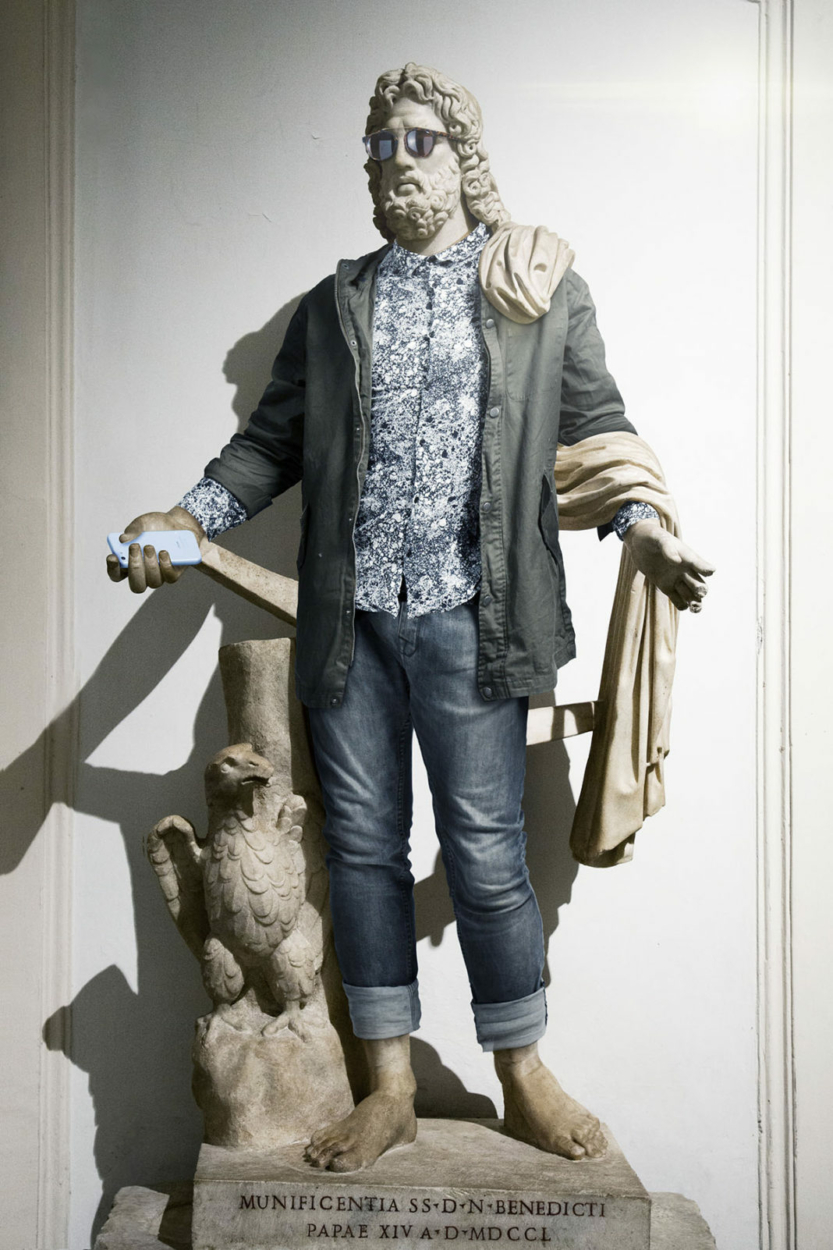In the introduction to Edith Hamilton’s Mythology (1940), the famed classicist describes the ancient beliefs of “uncivilized peoples everywhere”: the wrath of faceless gods could only be appeased by “some magical rite, senseless but powerful, or in some offering made at the cost of pain and grief.” As evidence, she points to the Egyptian deities: “a woman with a cat’s head, suggesting inflexible, inhuman cruelty. Or a monstrous, mysterious sphinx, aloof from all that lives.”
By contrast, the Greeks “made the gods in their own image”; they made the unknown known. They confined their deities to geography, involved them in human affairs, gave them human faces. Hamilton writes that “the whole divine company … were entrancingly beautiful with a human beauty … The early Greek mythologists transformed a world full of fear into a world full of beauty.” If there be monsters (satyrs, centaurs, Scylla and Charybdis), they appear in the earliest, most “primitive” myths, before ceding the stage to the humanized gods. Hamilton continues:
The great hero of Greek mythology, Hercules, might be an allegory of Greece herself. He fought the monsters and freed the earth from them just as Greece freed the earth from the monstrous idea of the unhuman supreme over the human.
 This was “a revolution in thought.” Not only were deities humanized, but the reverse became true, too: humans were deified. The more beautiful you were, the more godlike. Take the Doryphoros sculpture, “the Spear Bearer,” of whom the physician Galen wrote admiringly, “Such perfection in proportion …” Galen attributed the sculpture’s perfection to its measurable symmetry. Of the Doryphoros, the journalist Chloé Cooper Jones once wrote:
This was “a revolution in thought.” Not only were deities humanized, but the reverse became true, too: humans were deified. The more beautiful you were, the more godlike. Take the Doryphoros sculpture, “the Spear Bearer,” of whom the physician Galen wrote admiringly, “Such perfection in proportion …” Galen attributed the sculpture’s perfection to its measurable symmetry. Of the Doryphoros, the journalist Chloé Cooper Jones once wrote:
These perfect proportions were, for the Greeks and later for the artists of the Italian Renaissance, the true, objective measurement of human beauty. Beauty was not a subjective, individual experience, but rather a property that could be evaluated mathematically.
But our proportions did not reveal merely something as superficial as pleasing physical beauty. Plato believed that proportionality in the body was evidence of a divine architecture, the same that could be found in the intricate order of the natural world around us. A beautiful body conveyed an innate, divine harmony — the godly awe of many disparate parts functioning together in perfect relation to a whole. It was more than what made us beautiful — it was what made us virtuous, aligned with our ideal forms.
“Measure and proportion are everywhere identified with beauty and virtue,” Plato wrote. “Beauty, proportion, and truth … considered as one.”
Physical beauty was not only the way by which you obtained godlike status, but also the way by which you became most fully yourself. Tom Holland puts it this way, in Dominion:
To blaze like a golden flame, and to attain a godlike pitch of strength and valour: this it was, in the Iliad, to be most fully a man. Physical perfection and moral superiority were indissoluble: this was the assumption … only the base were ugly.
Along these lines, we find the myth of Cupid and Psyche: in it, the god of love tests the tie between beauty and truth. Having taken the human Psyche as his wife, Cupid visits her only at night, determined that she never sees his face. He does not want her to experience “the bliss of filling her eyes with his beauty,” lest she recognize him as a god and imperil their relationship. In Hamilton’s version, their marriage is like this:
When she felt him beside her and heard his voice softly murmuring in her ear, all her fears left her. She knew without seeing him that here was no monster or shape of terror, but the lover and husband she had longed and waited for.
Even faceless and mysterious, the god of love comforts Psyche; in his presence, her fears melt away. Her sisters, however, demand that he show his face. “There must be something very wrong,” her sisters convince Psyche, “for him so to shun the light of day.”
The story bears a striking similarity to the Hebrew stories of YHWH, whose face “no man can see and live,” who famously “hideth his face from the house of Jacob,” his chosen people — his metaphorical wife. Both traditions are addressing an obvious conflict in religious life: the manifest presence and hiddenness of the divine. Perhaps that’s why C. S. Lewis felt compelled to retell Cupid and Psyche in his novel Till We Have Faces.
*
Till We Have Faces is told from the perspective of Orual, one of Psyche’s sisters. Despite being a princess (and later queen), she is considered ugly and is treated unjustly because of it. “It’s a pity about her face,” says the man with whom she falls, sadly, in love.
As in ancient Greece, Orual’s ugliness condemns her to loneliness and moral lowliness. In the original myth, the morality of Psyche’s sisters is represented by their physical appearance: admittedly beautiful, but compared to Psyche, “inexpressibly inferior” and consequently “wicked.” Their physical inferiority also reflects their moral inferiority. Orual strives to be good, but she is only considered so when she hides her face.
She learns to cover her face with a veil, a decision that proves useful in her professional life: unable to see her, people respect and fear her. But the veil also obscures her true expressions and feelings.
Despite being set in a 1956 fantasy version of ancient Greece, Orual’s conflict feels startlingly modern. Entire markets have blossomed in service of covering up. We often think that when one looks well, one is well. Frustratingly, our “Christianized” world still gives credence to the idea that there is some connection between beauty and goodness. Probably all of us know some, if not many, deeply beautiful people with unconventional, asymmetrical — ugly — faces.

Still, we like things better when their surface is shiny. But we condemn ugliness to our detriment. At least as much judgment as we pass on others we pass on ourselves. Orual spies this cycle of judgment undoing herself and her relationships. Beauty, she realizes, is in her world a form of divine currency:
“Can it be that you really don’t understand? Do you think we mortals will find you gods easier to bear if you’re beautiful? I tell you that if that’s true we’ll find you a thousand times worse.”
What Hamilton sees as a “revolution in thought” is of no help to Orual; beauty is no justification for anyone, least of all the gods. Lewis, who was a great Christian apologist, is drawing our attention to one of the ways that Jesus’s values differ from those of ancient civilizations — and in fact, modern ones, too.
In Christianity, God has a face, but the Bible never cares for its symmetry. Multitudes of people are moved by the authority of Jesus — the way he speaks — but not his physical beauty. In fact, the opposite seems to be the case: “he had no form or majesty that we should look at him, / nothing in his appearance that we should desire him” (Is 53:2). This is why Renaissance art is fine but also very weird.
It takes quite a bit of fortune to maintain appearances, but the Son of Man had no place to rest his head. When we think of the face of God, we should not imagine the smooth surface of the Doryphoros. We should think of the spit and mud that Veronica (in some traditions) wiped from it as he dragged his cross to Calvary. We should think of the vulnerable skin that was pierced as a crown of thorns was pushed onto his scalp.
In Lewis’ most famous line from the book, he relates our physical appearance to our spiritual condition: “How can [the gods] meet us face to face till we have faces?” Lewis is not saying that we must appear a certain way but that we must appear, period. The veils we hide behind must be dropped.
“Being seen by people we care about is a fundamental part of our mental health,” wrote Amanda Mull in the Atlantic recently. Mull reported that after a long period of social distancing, Americans are eager to be looked at again, since we have become invisible to so many for so long.
But more than that, Americans also want to be hot. We want to be judged well. According to Mull, we are in the midst of “a beauty boom.” Salon bookings have surged over the last few weeks, along with the demand for cosmetic injectables. In advertising for their workout equipment, the athletic company GymSource recently warned, “SUMMER IS COMING. SOON PEOPLE WILL BE SEEING YOU.”
To the ugly Greeks, this is the worst news ever. Put a veil over your face, never go outside. Hide! But to believers in the God who blesses the poor, the marginalized, the downtrodden, the disabled, and yes, even the ugly, it is the best news. Soon people will be seeing you.
Images by Leo Caillard.

COMMENTS
One response to “How to Look Moral According to Beautiful Greeks”
Leave a Reply













[…] today’s harmful laws of beauty. There’s nothing compatible with the gospel of Jesus and the superiority we tend to associate with “good […]